These are some videos I made a while ago. Nothing serious, I was fooling around with my camera's "video" button, and just recently posted them to Youtube. I expect that in the future I'll be more often using video on this blog, don't worry they'll be of a higher quality! Press play on the screen to watch the video, obviously. All the clips are just 15 seconds or so.
- The Bund - this is taken from the crowded viewing plaza of the Bund. On my side are the buildings on turn-of the-20th-century banks, on the other side of the river are the turn-of-the-21st-century skyscrapers. Check out the huge crowds. This is about as crowded as Shanghai gets.
- Suzhou's Taoist Temple of Mystery - the scene in front of the temple on a lazy Sunday. I turn a 360 and it can perhaps induce motion sickness, but I think it give a good feel for what it's like.
- Happy Avenue - as a warning, this is basically a bunch of noise, serving as the end of a song. The band was actually pretty cool, if inconsistent.
- Shangai Rapping - To the best of my knowledge, Shanghainese can't rap. Give it a look and see if you agree.
Sunday, July 30, 2006
Friday, July 28, 2006
Reflections After One Year in Shanghai
I've been in China for more than a year now, unbelievable! It hardly makes me an expert opinion but I'll use it as an excuse to ramble on some about some observations:
- Chinese is difficult. I work on my lingo skills very hard and I thought after a year I would pretty much be talking it fluent. Instead my level is casual conversation, and I couldn't dream of understanding the newspaper.
- Food is boring. I eat out every single meal, the bland food has gotten so tiresome. When you do get a good meal it's a matter of luck - go to the same restaurant and order the same dish the next week, and it'll taste half different. It's not a question of meeting American tastes, I flat out think the Chinese food in Oakland's Chinatown was better. With the caveat that I would miss all the street foods and snacks.
I should mention that unless I'm meeting friends I eat entirely meals that sell for a dollar or less, or fast food when I'm jonesing for something non-Chinese. May sound stupid, but the more expensive restaurants aren't any better to my mind. Oh, and the non-Chinese style food in Shanghai is terrible and wildly over-priced, although sometimes I eat at this one Thai place that is OK.
- People are pretty chill. I don't think I've chatted with anybody who I didn't think was at least pleasant. I would definitely say that some of the people I've met are really cool and very friendly and a lot of fun to kick it with. On the other hand, meeting new people is difficult, the language barrier is no small part of that. And people here are unlikely to have a wide range of experiences and interests.
- Shanghai's night life is sorry. Despite Shanghai's reputation as a crazy decadent city, there is a serious lack of luxury money being spent. The music scene is incredibly small, for instance, and the best bands would be lucky to open a show in the US. The bars are very boring and entirely oriented towards foreigners - nothing wrong with foreigners obviously, but a larger range would be fun.
- The streets are something druggish. I don't get it. I realize on an intellectual level that they're busy, but in reality I just slough my way through without noticing. All the same I can't imagine going back to the empty sidewalks of the US. All the hustle and activity excites my dopamine receptors on some subliminal level.
- Shanghai is either a lie or a desperate gamble. How can a city that is a majority wildly poor and doesn't seem to have a strong capitalist streak or a particular economic reason to exist also seem to work so smoothly, to be growing so quickly, and to have areas that are so obviously impressive? I'm not qualified to do more than observe and wonder.
- Chinese is difficult. I work on my lingo skills very hard and I thought after a year I would pretty much be talking it fluent. Instead my level is casual conversation, and I couldn't dream of understanding the newspaper.
- Food is boring. I eat out every single meal, the bland food has gotten so tiresome. When you do get a good meal it's a matter of luck - go to the same restaurant and order the same dish the next week, and it'll taste half different. It's not a question of meeting American tastes, I flat out think the Chinese food in Oakland's Chinatown was better. With the caveat that I would miss all the street foods and snacks.
I should mention that unless I'm meeting friends I eat entirely meals that sell for a dollar or less, or fast food when I'm jonesing for something non-Chinese. May sound stupid, but the more expensive restaurants aren't any better to my mind. Oh, and the non-Chinese style food in Shanghai is terrible and wildly over-priced, although sometimes I eat at this one Thai place that is OK.
- People are pretty chill. I don't think I've chatted with anybody who I didn't think was at least pleasant. I would definitely say that some of the people I've met are really cool and very friendly and a lot of fun to kick it with. On the other hand, meeting new people is difficult, the language barrier is no small part of that. And people here are unlikely to have a wide range of experiences and interests.
- Shanghai's night life is sorry. Despite Shanghai's reputation as a crazy decadent city, there is a serious lack of luxury money being spent. The music scene is incredibly small, for instance, and the best bands would be lucky to open a show in the US. The bars are very boring and entirely oriented towards foreigners - nothing wrong with foreigners obviously, but a larger range would be fun.
- The streets are something druggish. I don't get it. I realize on an intellectual level that they're busy, but in reality I just slough my way through without noticing. All the same I can't imagine going back to the empty sidewalks of the US. All the hustle and activity excites my dopamine receptors on some subliminal level.
- Shanghai is either a lie or a desperate gamble. How can a city that is a majority wildly poor and doesn't seem to have a strong capitalist streak or a particular economic reason to exist also seem to work so smoothly, to be growing so quickly, and to have areas that are so obviously impressive? I'm not qualified to do more than observe and wonder.
Saturday, July 15, 2006
Karaoke
Karaoke is probably the most popular form of entertainment in Shanghai, maybe alongside bootleg DVDs. Still, I've been here almost a year, and had avoided going all this time. Don't get me wrong, I like Karaoke fine, I did it sometimes in the US and always enjoyed myself. But as the number one form of entertainment, I just don't understand.
Oh, and I won't lie: the pictures are awful on this one. My cameraphone takes OK pictures in bright light, but at night it's just horrid.
I went after work, my first reaction when I entered was almost to laugh! I think of karaoke places as sightly seedy, but this karaoke place was like a huge office tower. Cancel that, all the clean dark surfaces and weird lighting and glass elevators made it a huge office tower - of the future!

It's the private karaoke booths, not the larger karaoke halls and bars that are more common in the US. I asked some people about it and they told me ten years ago karaoke bars were very common, but now it's pretty rare. I also asked the people how often they went. Defying stereotypes, they told me they hadn't been in a long time, or just once or twice in the past year...definitely there's people who go every week, though. It's also worth mentioning that some Karaoke joints are often basically hostess bars or straightforward fronts for prostitution.
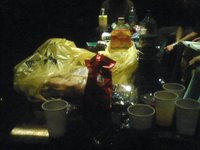 We brought our own food and drinks, mostly chips and soda, although we weren't allowed to bring in our own alcohol- you had to buy that from the hall, at big mark-ups of course. Only one of our group smoked, but there were ashtrays everywhere and a crazy-strong air ventilation system, so obviously they're prepared for the possibility of more. Near our room was some gourmet-looking food on fancy metal platters.
We brought our own food and drinks, mostly chips and soda, although we weren't allowed to bring in our own alcohol- you had to buy that from the hall, at big mark-ups of course. Only one of our group smoked, but there were ashtrays everywhere and a crazy-strong air ventilation system, so obviously they're prepared for the possibility of more. Near our room was some gourmet-looking food on fancy metal platters.

 Inside the room, it was dark with evil red lighting. I admit I didn't really enjoy myself, although it was fun to see that a couple of the people I know actually have really amazing voices - I wouldn't have suspected it. My problem was, I don't know most of the popular songs here. OK a lot of them I've heard around and could even hum the melodies, but I don't really have any attachment. They're pretty mindless and often just the Chinese equivalent to the Backstreet Boys or other overly manufactured pop.
Inside the room, it was dark with evil red lighting. I admit I didn't really enjoy myself, although it was fun to see that a couple of the people I know actually have really amazing voices - I wouldn't have suspected it. My problem was, I don't know most of the popular songs here. OK a lot of them I've heard around and could even hum the melodies, but I don't really have any attachment. They're pretty mindless and often just the Chinese equivalent to the Backstreet Boys or other overly manufactured pop.
 The selection of English songs was really small, too, and took some guesswork - for instance, "kabingda" (or something like that, I forget) was a transliteration of "Carpenters." The only Carpenters song they has was "Yesterday Once More," probably the all-time most popular song in China - you hear it everywhere, including blasting out over speakers at the construction site near my apartment.
The selection of English songs was really small, too, and took some guesswork - for instance, "kabingda" (or something like that, I forget) was a transliteration of "Carpenters." The only Carpenters song they has was "Yesterday Once More," probably the all-time most popular song in China - you hear it everywhere, including blasting out over speakers at the construction site near my apartment.
 They also had "I Want You Back," although it wasn't the familiar Jackson 5 version. You could choose through the book, but mostly we used a computer system to pick the songs.
They also had "I Want You Back," although it wasn't the familiar Jackson 5 version. You could choose through the book, but mostly we used a computer system to pick the songs.
Oh, and I won't lie: the pictures are awful on this one. My cameraphone takes OK pictures in bright light, but at night it's just horrid.
I went after work, my first reaction when I entered was almost to laugh! I think of karaoke places as sightly seedy, but this karaoke place was like a huge office tower. Cancel that, all the clean dark surfaces and weird lighting and glass elevators made it a huge office tower - of the future!

It's the private karaoke booths, not the larger karaoke halls and bars that are more common in the US. I asked some people about it and they told me ten years ago karaoke bars were very common, but now it's pretty rare. I also asked the people how often they went. Defying stereotypes, they told me they hadn't been in a long time, or just once or twice in the past year...definitely there's people who go every week, though. It's also worth mentioning that some Karaoke joints are often basically hostess bars or straightforward fronts for prostitution.
 We brought our own food and drinks, mostly chips and soda, although we weren't allowed to bring in our own alcohol- you had to buy that from the hall, at big mark-ups of course. Only one of our group smoked, but there were ashtrays everywhere and a crazy-strong air ventilation system, so obviously they're prepared for the possibility of more. Near our room was some gourmet-looking food on fancy metal platters.
We brought our own food and drinks, mostly chips and soda, although we weren't allowed to bring in our own alcohol- you had to buy that from the hall, at big mark-ups of course. Only one of our group smoked, but there were ashtrays everywhere and a crazy-strong air ventilation system, so obviously they're prepared for the possibility of more. Near our room was some gourmet-looking food on fancy metal platters. 
 Inside the room, it was dark with evil red lighting. I admit I didn't really enjoy myself, although it was fun to see that a couple of the people I know actually have really amazing voices - I wouldn't have suspected it. My problem was, I don't know most of the popular songs here. OK a lot of them I've heard around and could even hum the melodies, but I don't really have any attachment. They're pretty mindless and often just the Chinese equivalent to the Backstreet Boys or other overly manufactured pop.
Inside the room, it was dark with evil red lighting. I admit I didn't really enjoy myself, although it was fun to see that a couple of the people I know actually have really amazing voices - I wouldn't have suspected it. My problem was, I don't know most of the popular songs here. OK a lot of them I've heard around and could even hum the melodies, but I don't really have any attachment. They're pretty mindless and often just the Chinese equivalent to the Backstreet Boys or other overly manufactured pop.  The selection of English songs was really small, too, and took some guesswork - for instance, "kabingda" (or something like that, I forget) was a transliteration of "Carpenters." The only Carpenters song they has was "Yesterday Once More," probably the all-time most popular song in China - you hear it everywhere, including blasting out over speakers at the construction site near my apartment.
The selection of English songs was really small, too, and took some guesswork - for instance, "kabingda" (or something like that, I forget) was a transliteration of "Carpenters." The only Carpenters song they has was "Yesterday Once More," probably the all-time most popular song in China - you hear it everywhere, including blasting out over speakers at the construction site near my apartment. They also had "I Want You Back," although it wasn't the familiar Jackson 5 version. You could choose through the book, but mostly we used a computer system to pick the songs.
They also had "I Want You Back," although it wasn't the familiar Jackson 5 version. You could choose through the book, but mostly we used a computer system to pick the songs.
Sunday, July 09, 2006
Beer
Beer is something easy to both love and hate in Shanghai. On one hand, there's no denying that the beer in Shanghai is no damn good. On the other hand, it isn't particularly bad, it is generally very cheap, and it goes well with Shanghai's humidity.
I mentioned before about cheap Chinese Booze. The distinct tastes of Chinese hard alcohol definitely requires acquiring. Chinese beer is the opposite: for the most part it's impossibly generic, with very little taste beyond a watery sweetness. It's often of a light lager style that I associate with American mass-produced beers.

The beer is typically sold in 640 mL bottles, about twice as large as a normal 355mL bottle of beer. It's also sold as cans or sometimes in different-sized bottles. The bottles have the manufacture date stamped and the shelf life printed on the label, rather than the expiration date stamped as in many countries.
China doesn't have a legal drinking age, although a bar would be reluctant to serve children. Drinking in Shanghai often takes place with meals, either at home or at restaurants. My neighborhood has dozens of restaurants but no corner bars, and the bars that do exist in Shanghai are dominated by foreigners and the friends of foreigners. Overall I think Chinese people drink much much less than Westerners.
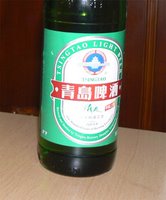 Tsingtao Light Beer - Tsingtao is probably the only Chinese beer that comes to mind for a non-Chinese person. The beer goes for about fourty cents for the large bottle. Even at a restaurant, it'll only be marked up to half a dollar. At a bar, though, it can easily cost five dollars - bars are most aimed at Westerners with lots of free cash. The English name says Light, but really it's just cheap - it's worth paying the extra dime to get the mid level Tsingtao, or even upgrade to:
Tsingtao Light Beer - Tsingtao is probably the only Chinese beer that comes to mind for a non-Chinese person. The beer goes for about fourty cents for the large bottle. Even at a restaurant, it'll only be marked up to half a dollar. At a bar, though, it can easily cost five dollars - bars are most aimed at Westerners with lots of free cash. The English name says Light, but really it's just cheap - it's worth paying the extra dime to get the mid level Tsingtao, or even upgrade to:
 This is Tsingtao's premium beer, selling for eighty cents a bottle. Many beer labels will offer a large number of different labels and qualities of beer. I would call this the best lager-style beer available in China, although it loses points by force of having a light skunk smell. And to be honest, the difference between this beer and every other Chinese lager is somewhat subtle. Update 5/31/2007 - I noticed that premium Tsingtao beer is now widely available in San Francisco and Oakland. I didn't see it in Honolulu so I'm guessing it's being test-marketed. If you see it for sale, I recommend giving it a try!
This is Tsingtao's premium beer, selling for eighty cents a bottle. Many beer labels will offer a large number of different labels and qualities of beer. I would call this the best lager-style beer available in China, although it loses points by force of having a light skunk smell. And to be honest, the difference between this beer and every other Chinese lager is somewhat subtle. Update 5/31/2007 - I noticed that premium Tsingtao beer is now widely available in San Francisco and Oakland. I didn't see it in Honolulu so I'm guessing it's being test-marketed. If you see it for sale, I recommend giving it a try!
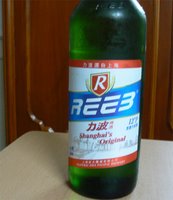 Reeb is the cheapest commonly available beer. Their beers are extremely neutral and flavorless. They don't have Tsingtao's slight skunk smell, possibly because the Reeb in Shanghai is usually very fresh - the stores near my house will have beers that are only a week or two old. Reeb has a number of different variations, this is the Shanghai-produced version that would possibly be wildly popular in the US. It's bottled at 12 proof, which in the US would make it a malt liquor - Mickey's are 11.4 proof. Also, the 24 oz sells for 36 cents.
Reeb is the cheapest commonly available beer. Their beers are extremely neutral and flavorless. They don't have Tsingtao's slight skunk smell, possibly because the Reeb in Shanghai is usually very fresh - the stores near my house will have beers that are only a week or two old. Reeb has a number of different variations, this is the Shanghai-produced version that would possibly be wildly popular in the US. It's bottled at 12 proof, which in the US would make it a malt liquor - Mickey's are 11.4 proof. Also, the 24 oz sells for 36 cents.
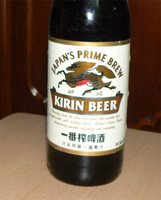 Kirin is a Japanese labeled, locally-produced beer popular in China, selling a cheaper flavorless variation, and a version that tastes more like the Japanese beer, although still lacking much flavor. The premium version is almost as good as Tsingtao premium. Japanese beers are pretty common - most popular is Suntory, which sells premium spirits in other countries but competes with Reeb for the low end beer market in Shanghai. Asahi is somewhat common - along with Kirin, it really advertises heavily.
Kirin is a Japanese labeled, locally-produced beer popular in China, selling a cheaper flavorless variation, and a version that tastes more like the Japanese beer, although still lacking much flavor. The premium version is almost as good as Tsingtao premium. Japanese beers are pretty common - most popular is Suntory, which sells premium spirits in other countries but competes with Reeb for the low end beer market in Shanghai. Asahi is somewhat common - along with Kirin, it really advertises heavily.

 Budweiser sells a normal and a premium beer, although confusingly enough the difference in prices is small - seventy five cents, compared to eighty five cents. It's the only American brand that manufactures here. Heineken manufactures in China as well, selling a large bottle for $1.35. Personally I think Budweiser and Heineken are flavorless, with both Tsingtao and Kirin's beers being a much better value. But I'm aware many foreigners in Shanghai think Heineken is just great. Guinness manufactures a variation of their beer for the Chinese and Indonesian market. It's lighter and generally tastes different than the Guinness back home, isn't all that easy to find, and sells at $1.50 for an American-sized bottle, but is still pretty good.
Budweiser sells a normal and a premium beer, although confusingly enough the difference in prices is small - seventy five cents, compared to eighty five cents. It's the only American brand that manufactures here. Heineken manufactures in China as well, selling a large bottle for $1.35. Personally I think Budweiser and Heineken are flavorless, with both Tsingtao and Kirin's beers being a much better value. But I'm aware many foreigners in Shanghai think Heineken is just great. Guinness manufactures a variation of their beer for the Chinese and Indonesian market. It's lighter and generally tastes different than the Guinness back home, isn't all that easy to find, and sells at $1.50 for an American-sized bottle, but is still pretty good.
 At grocery stores targetting foreigners, or at Lianhua's fancier import-oriented grocery stories, it's not all that difficult to find imported beers from Europe in China, although they're much more expensive and not entirely fresh. This Hoegaarden is certainly interesting, more resembling a Sprite more than what I consider a beer, although still pretty tasty. Anyway I have to say that the best beer you can find in Shanghai is a Newcastle - but at $3 for a large-ish can, it's too expensive. The only American import you can find is Samuel Adams. I wouldn't order it in the US, but I consider it a contender for the best beer available in Shanghai - and $1.50 for an American-size bottle is more reasonable.
At grocery stores targetting foreigners, or at Lianhua's fancier import-oriented grocery stories, it's not all that difficult to find imported beers from Europe in China, although they're much more expensive and not entirely fresh. This Hoegaarden is certainly interesting, more resembling a Sprite more than what I consider a beer, although still pretty tasty. Anyway I have to say that the best beer you can find in Shanghai is a Newcastle - but at $3 for a large-ish can, it's too expensive. The only American import you can find is Samuel Adams. I wouldn't order it in the US, but I consider it a contender for the best beer available in Shanghai - and $1.50 for an American-size bottle is more reasonable.
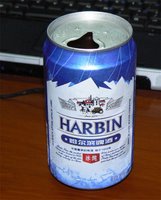 I'll put Harbin Beer as the worst beer I've had in Shanghai. The taste itself is fine, but the water used is entirely metallic. It leaves an unsettling rust aftertaste and I really couldn't finish the can. Making it all the more dissappointing, I looked around to find it. The search showed the oddities of the Chinese distribution system. It's pretty common to find at restaurants, but I can't find it at even the largest grocery stores. Finally I found a chain convenience store with a few cans, although other convenience stores of the chain don't carry it. Actually I also tried a bottle of this at a restaurant, and I thought it was decent, so it could be a canning problem, or maybe the spicy food had numbed my tastebuds.
I'll put Harbin Beer as the worst beer I've had in Shanghai. The taste itself is fine, but the water used is entirely metallic. It leaves an unsettling rust aftertaste and I really couldn't finish the can. Making it all the more dissappointing, I looked around to find it. The search showed the oddities of the Chinese distribution system. It's pretty common to find at restaurants, but I can't find it at even the largest grocery stores. Finally I found a chain convenience store with a few cans, although other convenience stores of the chain don't carry it. Actually I also tried a bottle of this at a restaurant, and I thought it was decent, so it could be a canning problem, or maybe the spicy food had numbed my tastebuds.
 Light lagers dominate Chinese beers, but in the last year Reeb has made a large push with a dark, more flavorful beer. It's available at most grocery stores and convenience stores. I'm all for the idea of doing something different, but this beer is truly awful - it tasted unbearably sweet, with a flavor reminding me of what I don't like about Sarsaparilla Soda. I'd rather try Xinjiang's dark beer, which I hear is excellent, but I've never seen in a store.
Light lagers dominate Chinese beers, but in the last year Reeb has made a large push with a dark, more flavorful beer. It's available at most grocery stores and convenience stores. I'm all for the idea of doing something different, but this beer is truly awful - it tasted unbearably sweet, with a flavor reminding me of what I don't like about Sarsaparilla Soda. I'd rather try Xinjiang's dark beer, which I hear is excellent, but I've never seen in a store.
 Much better than Reeb is Tsingtao's take at dark beer - actually, they have two. The first I tried was directly bottled under the Tsingtao name, and is the most expensive Chinese-label beer I know of, costing $1 for a US-size bottle. The beer is pretty tasty, but has an unfortunate aftertaste resembling soy sauce. Better is the slightly cheaper dark beer they manufacture under the Haidao Black Beer label. The aftertaste is strongly of chocolates, toffee, and vanilla, giving it a desert feel that might be a little unusual, but keeps it interesting enough that I'd drink it from time to time, even if I was back in the US. And to be honest, that's the only Chinese beer I can say that about.
Much better than Reeb is Tsingtao's take at dark beer - actually, they have two. The first I tried was directly bottled under the Tsingtao name, and is the most expensive Chinese-label beer I know of, costing $1 for a US-size bottle. The beer is pretty tasty, but has an unfortunate aftertaste resembling soy sauce. Better is the slightly cheaper dark beer they manufacture under the Haidao Black Beer label. The aftertaste is strongly of chocolates, toffee, and vanilla, giving it a desert feel that might be a little unusual, but keeps it interesting enough that I'd drink it from time to time, even if I was back in the US. And to be honest, that's the only Chinese beer I can say that about.
And I almost forgot to mention two important details. First, that beer is often served warm at the cheaper restaurants. Gross! There's a line of Yin-Yang medicine belief that cold drinks are bad for your health. Also refrigerators are kind of expensive. Also there is actually a second Chinese-produced American beer, although it's hard to find. Surprisingly enough, it's...Pabst!

I mentioned before about cheap Chinese Booze. The distinct tastes of Chinese hard alcohol definitely requires acquiring. Chinese beer is the opposite: for the most part it's impossibly generic, with very little taste beyond a watery sweetness. It's often of a light lager style that I associate with American mass-produced beers.

The beer is typically sold in 640 mL bottles, about twice as large as a normal 355mL bottle of beer. It's also sold as cans or sometimes in different-sized bottles. The bottles have the manufacture date stamped and the shelf life printed on the label, rather than the expiration date stamped as in many countries.
China doesn't have a legal drinking age, although a bar would be reluctant to serve children. Drinking in Shanghai often takes place with meals, either at home or at restaurants. My neighborhood has dozens of restaurants but no corner bars, and the bars that do exist in Shanghai are dominated by foreigners and the friends of foreigners. Overall I think Chinese people drink much much less than Westerners.
 Tsingtao Light Beer - Tsingtao is probably the only Chinese beer that comes to mind for a non-Chinese person. The beer goes for about fourty cents for the large bottle. Even at a restaurant, it'll only be marked up to half a dollar. At a bar, though, it can easily cost five dollars - bars are most aimed at Westerners with lots of free cash. The English name says Light, but really it's just cheap - it's worth paying the extra dime to get the mid level Tsingtao, or even upgrade to:
Tsingtao Light Beer - Tsingtao is probably the only Chinese beer that comes to mind for a non-Chinese person. The beer goes for about fourty cents for the large bottle. Even at a restaurant, it'll only be marked up to half a dollar. At a bar, though, it can easily cost five dollars - bars are most aimed at Westerners with lots of free cash. The English name says Light, but really it's just cheap - it's worth paying the extra dime to get the mid level Tsingtao, or even upgrade to: This is Tsingtao's premium beer, selling for eighty cents a bottle. Many beer labels will offer a large number of different labels and qualities of beer. I would call this the best lager-style beer available in China, although it loses points by force of having a light skunk smell. And to be honest, the difference between this beer and every other Chinese lager is somewhat subtle. Update 5/31/2007 - I noticed that premium Tsingtao beer is now widely available in San Francisco and Oakland. I didn't see it in Honolulu so I'm guessing it's being test-marketed. If you see it for sale, I recommend giving it a try!
This is Tsingtao's premium beer, selling for eighty cents a bottle. Many beer labels will offer a large number of different labels and qualities of beer. I would call this the best lager-style beer available in China, although it loses points by force of having a light skunk smell. And to be honest, the difference between this beer and every other Chinese lager is somewhat subtle. Update 5/31/2007 - I noticed that premium Tsingtao beer is now widely available in San Francisco and Oakland. I didn't see it in Honolulu so I'm guessing it's being test-marketed. If you see it for sale, I recommend giving it a try! Reeb is the cheapest commonly available beer. Their beers are extremely neutral and flavorless. They don't have Tsingtao's slight skunk smell, possibly because the Reeb in Shanghai is usually very fresh - the stores near my house will have beers that are only a week or two old. Reeb has a number of different variations, this is the Shanghai-produced version that would possibly be wildly popular in the US. It's bottled at 12 proof, which in the US would make it a malt liquor - Mickey's are 11.4 proof. Also, the 24 oz sells for 36 cents.
Reeb is the cheapest commonly available beer. Their beers are extremely neutral and flavorless. They don't have Tsingtao's slight skunk smell, possibly because the Reeb in Shanghai is usually very fresh - the stores near my house will have beers that are only a week or two old. Reeb has a number of different variations, this is the Shanghai-produced version that would possibly be wildly popular in the US. It's bottled at 12 proof, which in the US would make it a malt liquor - Mickey's are 11.4 proof. Also, the 24 oz sells for 36 cents.  Kirin is a Japanese labeled, locally-produced beer popular in China, selling a cheaper flavorless variation, and a version that tastes more like the Japanese beer, although still lacking much flavor. The premium version is almost as good as Tsingtao premium. Japanese beers are pretty common - most popular is Suntory, which sells premium spirits in other countries but competes with Reeb for the low end beer market in Shanghai. Asahi is somewhat common - along with Kirin, it really advertises heavily.
Kirin is a Japanese labeled, locally-produced beer popular in China, selling a cheaper flavorless variation, and a version that tastes more like the Japanese beer, although still lacking much flavor. The premium version is almost as good as Tsingtao premium. Japanese beers are pretty common - most popular is Suntory, which sells premium spirits in other countries but competes with Reeb for the low end beer market in Shanghai. Asahi is somewhat common - along with Kirin, it really advertises heavily.
 Budweiser sells a normal and a premium beer, although confusingly enough the difference in prices is small - seventy five cents, compared to eighty five cents. It's the only American brand that manufactures here. Heineken manufactures in China as well, selling a large bottle for $1.35. Personally I think Budweiser and Heineken are flavorless, with both Tsingtao and Kirin's beers being a much better value. But I'm aware many foreigners in Shanghai think Heineken is just great. Guinness manufactures a variation of their beer for the Chinese and Indonesian market. It's lighter and generally tastes different than the Guinness back home, isn't all that easy to find, and sells at $1.50 for an American-sized bottle, but is still pretty good.
Budweiser sells a normal and a premium beer, although confusingly enough the difference in prices is small - seventy five cents, compared to eighty five cents. It's the only American brand that manufactures here. Heineken manufactures in China as well, selling a large bottle for $1.35. Personally I think Budweiser and Heineken are flavorless, with both Tsingtao and Kirin's beers being a much better value. But I'm aware many foreigners in Shanghai think Heineken is just great. Guinness manufactures a variation of their beer for the Chinese and Indonesian market. It's lighter and generally tastes different than the Guinness back home, isn't all that easy to find, and sells at $1.50 for an American-sized bottle, but is still pretty good. At grocery stores targetting foreigners, or at Lianhua's fancier import-oriented grocery stories, it's not all that difficult to find imported beers from Europe in China, although they're much more expensive and not entirely fresh. This Hoegaarden is certainly interesting, more resembling a Sprite more than what I consider a beer, although still pretty tasty. Anyway I have to say that the best beer you can find in Shanghai is a Newcastle - but at $3 for a large-ish can, it's too expensive. The only American import you can find is Samuel Adams. I wouldn't order it in the US, but I consider it a contender for the best beer available in Shanghai - and $1.50 for an American-size bottle is more reasonable.
At grocery stores targetting foreigners, or at Lianhua's fancier import-oriented grocery stories, it's not all that difficult to find imported beers from Europe in China, although they're much more expensive and not entirely fresh. This Hoegaarden is certainly interesting, more resembling a Sprite more than what I consider a beer, although still pretty tasty. Anyway I have to say that the best beer you can find in Shanghai is a Newcastle - but at $3 for a large-ish can, it's too expensive. The only American import you can find is Samuel Adams. I wouldn't order it in the US, but I consider it a contender for the best beer available in Shanghai - and $1.50 for an American-size bottle is more reasonable. I'll put Harbin Beer as the worst beer I've had in Shanghai. The taste itself is fine, but the water used is entirely metallic. It leaves an unsettling rust aftertaste and I really couldn't finish the can. Making it all the more dissappointing, I looked around to find it. The search showed the oddities of the Chinese distribution system. It's pretty common to find at restaurants, but I can't find it at even the largest grocery stores. Finally I found a chain convenience store with a few cans, although other convenience stores of the chain don't carry it. Actually I also tried a bottle of this at a restaurant, and I thought it was decent, so it could be a canning problem, or maybe the spicy food had numbed my tastebuds.
I'll put Harbin Beer as the worst beer I've had in Shanghai. The taste itself is fine, but the water used is entirely metallic. It leaves an unsettling rust aftertaste and I really couldn't finish the can. Making it all the more dissappointing, I looked around to find it. The search showed the oddities of the Chinese distribution system. It's pretty common to find at restaurants, but I can't find it at even the largest grocery stores. Finally I found a chain convenience store with a few cans, although other convenience stores of the chain don't carry it. Actually I also tried a bottle of this at a restaurant, and I thought it was decent, so it could be a canning problem, or maybe the spicy food had numbed my tastebuds. Light lagers dominate Chinese beers, but in the last year Reeb has made a large push with a dark, more flavorful beer. It's available at most grocery stores and convenience stores. I'm all for the idea of doing something different, but this beer is truly awful - it tasted unbearably sweet, with a flavor reminding me of what I don't like about Sarsaparilla Soda. I'd rather try Xinjiang's dark beer, which I hear is excellent, but I've never seen in a store.
Light lagers dominate Chinese beers, but in the last year Reeb has made a large push with a dark, more flavorful beer. It's available at most grocery stores and convenience stores. I'm all for the idea of doing something different, but this beer is truly awful - it tasted unbearably sweet, with a flavor reminding me of what I don't like about Sarsaparilla Soda. I'd rather try Xinjiang's dark beer, which I hear is excellent, but I've never seen in a store. Much better than Reeb is Tsingtao's take at dark beer - actually, they have two. The first I tried was directly bottled under the Tsingtao name, and is the most expensive Chinese-label beer I know of, costing $1 for a US-size bottle. The beer is pretty tasty, but has an unfortunate aftertaste resembling soy sauce. Better is the slightly cheaper dark beer they manufacture under the Haidao Black Beer label. The aftertaste is strongly of chocolates, toffee, and vanilla, giving it a desert feel that might be a little unusual, but keeps it interesting enough that I'd drink it from time to time, even if I was back in the US. And to be honest, that's the only Chinese beer I can say that about.
Much better than Reeb is Tsingtao's take at dark beer - actually, they have two. The first I tried was directly bottled under the Tsingtao name, and is the most expensive Chinese-label beer I know of, costing $1 for a US-size bottle. The beer is pretty tasty, but has an unfortunate aftertaste resembling soy sauce. Better is the slightly cheaper dark beer they manufacture under the Haidao Black Beer label. The aftertaste is strongly of chocolates, toffee, and vanilla, giving it a desert feel that might be a little unusual, but keeps it interesting enough that I'd drink it from time to time, even if I was back in the US. And to be honest, that's the only Chinese beer I can say that about.And I almost forgot to mention two important details. First, that beer is often served warm at the cheaper restaurants. Gross! There's a line of Yin-Yang medicine belief that cold drinks are bad for your health. Also refrigerators are kind of expensive. Also there is actually a second Chinese-produced American beer, although it's hard to find. Surprisingly enough, it's...Pabst!

Monday, June 26, 2006
Taking Wuyi Mountain (By Strategy), Pt. 2
Continuing on with my trip to Wuyi Mountain, probably the highlight was taking a raft down the Nine Twists River. The river is very shallow as it winds its way through the mountains. The mode of transportation was small rafts made of bamboo tied together, with two men with poles who guide our way through. It's a popular tourist attraction and people line up for it like it was Disneyland.

You can notice the umbrellas and plastic rainjackets, it was raining really hard when the ride first started, but quickly got better. In a way that was for the best. It made the river a little rougher, at times it almost resembled white water rafting. What more to say? I'll just link up a few pictures, I hope it comes across how amazingly beautiful the whole ride was.



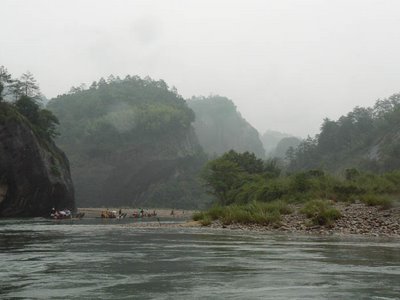
At the end of all of this was some ancient colleges, smallish compounds where the old-school version of graduate students would prepare for the incredibly demanding Imperial Examinations. Some of the associated scholars are very famous to the people I was with, and there were even calligraphy examples about a thousand years old from masters!

A side note: almost every Chinese person will tell you that the place where they were born has both the most beautiful scenery and the most delicious food. I'm no exception, so perhaps this extends beyond Chinese people...anyway while Wuyi Mountain may have a claim at the most beautiful, from what I ate there's no way it could stake a claim to the most delicious food. The lunch & dinners I had, at four different restaurants in total, were all very similar and vaguely inedible, despite the immense appetite I had worked up. My favorite was the spicy bamboo shoots and Oolong-tea flavored Tofu, local specialties. I also thought this pork dish was OK, until I lifted up a piece and saw one side was covered in fur! The people I was with told me that's how country-area restaurants go. There was no convenience store pre-prepared food or fast food to get as an alternative. Normally that wouldn't really be a problem, but I was really looking around for something.
Moving on, I hiked the also transcendant Heavenly Tour Peak. It was really very impressive, although many of the views resembled the views I showed in Pt. 1, so I won't go on too much about it. There were some impressive views of the Nine Twists River, showing through the fog:
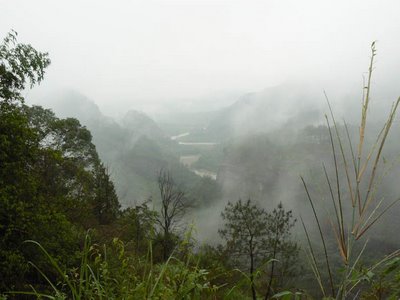
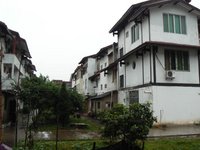 Wuyi Mountain City is small, a lot of the city housing looked like what is shown to the left. Most of the town seems to revolve around selling things to the tourists. Our tour guide led us to a few group buying sessions. That might sound like a rip-off, but they were actually extremely entertaining. At the one pictured below, the company's chief salesman and the seller engaged in some incredibly heated group bargaining for a variety of local products. Some people ended up getting bags and bags of stuff, but I only ended up getting a single bag of Oolong tea. Very high quality, but not well-packaged like you would want for a gift. It was sold at about $7 for half a pound. To me it seems like a lifetime supply, but other people were buying multiple bags, in addition to the more well-packaged teas.
Wuyi Mountain City is small, a lot of the city housing looked like what is shown to the left. Most of the town seems to revolve around selling things to the tourists. Our tour guide led us to a few group buying sessions. That might sound like a rip-off, but they were actually extremely entertaining. At the one pictured below, the company's chief salesman and the seller engaged in some incredibly heated group bargaining for a variety of local products. Some people ended up getting bags and bags of stuff, but I only ended up getting a single bag of Oolong tea. Very high quality, but not well-packaged like you would want for a gift. It was sold at about $7 for half a pound. To me it seems like a lifetime supply, but other people were buying multiple bags, in addition to the more well-packaged teas.
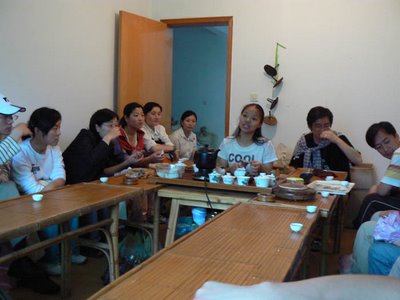
All around town they sold alcohol with snakes in it. I tried a little bit and found the taste surprisingly mellow. I'm guessing it comes from all the herbs, and that the snake has almost no influence on the taste of the alcohol.
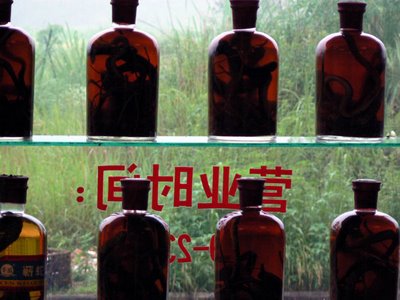
I really enjoyed this trip and would definitely recommend it to anyone in Shanghai with a free weekend. On the other hand, a lot of people told me Yellow Mountain, inland from Shanghai, is much the same but even more beautiful. I'll have to give it a look!

You can notice the umbrellas and plastic rainjackets, it was raining really hard when the ride first started, but quickly got better. In a way that was for the best. It made the river a little rougher, at times it almost resembled white water rafting. What more to say? I'll just link up a few pictures, I hope it comes across how amazingly beautiful the whole ride was.




At the end of all of this was some ancient colleges, smallish compounds where the old-school version of graduate students would prepare for the incredibly demanding Imperial Examinations. Some of the associated scholars are very famous to the people I was with, and there were even calligraphy examples about a thousand years old from masters!

A side note: almost every Chinese person will tell you that the place where they were born has both the most beautiful scenery and the most delicious food. I'm no exception, so perhaps this extends beyond Chinese people...anyway while Wuyi Mountain may have a claim at the most beautiful, from what I ate there's no way it could stake a claim to the most delicious food. The lunch & dinners I had, at four different restaurants in total, were all very similar and vaguely inedible, despite the immense appetite I had worked up. My favorite was the spicy bamboo shoots and Oolong-tea flavored Tofu, local specialties. I also thought this pork dish was OK, until I lifted up a piece and saw one side was covered in fur! The people I was with told me that's how country-area restaurants go. There was no convenience store pre-prepared food or fast food to get as an alternative. Normally that wouldn't really be a problem, but I was really looking around for something.
Moving on, I hiked the also transcendant Heavenly Tour Peak. It was really very impressive, although many of the views resembled the views I showed in Pt. 1, so I won't go on too much about it. There were some impressive views of the Nine Twists River, showing through the fog:

 Wuyi Mountain City is small, a lot of the city housing looked like what is shown to the left. Most of the town seems to revolve around selling things to the tourists. Our tour guide led us to a few group buying sessions. That might sound like a rip-off, but they were actually extremely entertaining. At the one pictured below, the company's chief salesman and the seller engaged in some incredibly heated group bargaining for a variety of local products. Some people ended up getting bags and bags of stuff, but I only ended up getting a single bag of Oolong tea. Very high quality, but not well-packaged like you would want for a gift. It was sold at about $7 for half a pound. To me it seems like a lifetime supply, but other people were buying multiple bags, in addition to the more well-packaged teas.
Wuyi Mountain City is small, a lot of the city housing looked like what is shown to the left. Most of the town seems to revolve around selling things to the tourists. Our tour guide led us to a few group buying sessions. That might sound like a rip-off, but they were actually extremely entertaining. At the one pictured below, the company's chief salesman and the seller engaged in some incredibly heated group bargaining for a variety of local products. Some people ended up getting bags and bags of stuff, but I only ended up getting a single bag of Oolong tea. Very high quality, but not well-packaged like you would want for a gift. It was sold at about $7 for half a pound. To me it seems like a lifetime supply, but other people were buying multiple bags, in addition to the more well-packaged teas.
All around town they sold alcohol with snakes in it. I tried a little bit and found the taste surprisingly mellow. I'm guessing it comes from all the herbs, and that the snake has almost no influence on the taste of the alcohol.

I really enjoyed this trip and would definitely recommend it to anyone in Shanghai with a free weekend. On the other hand, a lot of people told me Yellow Mountain, inland from Shanghai, is much the same but even more beautiful. I'll have to give it a look!
Wednesday, June 21, 2006
Taking Wuyi Mountain (By Strategy), Pt. 1
 I hesitated a little when first asked if I wanted to go on the company field trip to Wuyi Mountain. "I must think about it," I said. What I really meant was "I have never before heard of Wuyi Mountain, and must look it up on the Internet."
I hesitated a little when first asked if I wanted to go on the company field trip to Wuyi Mountain. "I must think about it," I said. What I really meant was "I have never before heard of Wuyi Mountain, and must look it up on the Internet."But of course I said yes, and I'm right glad that I did! Wuyi Mountain is in Fujian Province, near the coast and right across from Taiwan. Looking on the web, I learned it was also the area Hakka people are from, I thought it was somewhere west of Canton or something.
The company went there by taking the overnight 13 hour train. I've only taken the train once before in China, for the one-hour trip from Suzhou to Shanghai. Taking the overnight was very different. The train cars are real small and it's stacked three beds high. There were three dimensions of pain involved: first, as a very tall person, I was slightly longer than the bed itself. Secondly, the bed was very narrow, and certainly not wide enough for me to crouch in my sleep. I imagine if I was overweight it would be difficult just to fit! Third, there wasn't much headroom, not enough to sit up even.
The problems are worse when you have the top bunk. The bottom bunks are best, but during the day they're used as a couch by all the people in the above bunks. In the end it was no problem because I knew all the other people in the other bunks, but it would be really annoying to travel by yourself with such a set up. Anyway during the day we played this amazingly complicated card game. It was fun but even if I learned the rules, I'm still entirely lost about the strategies.

A serious bummer was that lights went out at 10, and the commotion started at 6 the next morning. I had a hard time sleeping on the train, and was unbelievably tired. Still I was stunned looking out the window of the train. I've barely been outside of Shanghai. With knowing naivite, I tell my friends that Shanghai is just another city, and China and the US are basically the same. But looking out the window it looked like a different world:

I definitely want to have a look at such an area sometime. Maybe visiting here would be something like kicking it with the Amish. Cattle were used to draw plows, and hills were terraced into irregular planes and used to harvest rice, often by hand. The best photo I got of that is a zoom from the above picture:

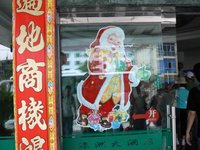 On arriving we first checked in to our hotel. Shanghai keeps Christmas signs up throughout winter, it's different but I think it's pretty chill, keeping the Christmas spirit going. However this hotel still had Santas up in June, and so did some of the other fancier hotels and restaurants throughout town. And it should be mentioned, the whole trip was one of the dreaded Chinese tour guided trips, hilarious! They had the flags and the whole business, they even had a small megaphone but they only used it once or twice. Anyway they were surprisingly not annoying, and they kept the whole thing orderly. To my complete shock I didn't mind it and would consider using one again, at least for a short vacation.
On arriving we first checked in to our hotel. Shanghai keeps Christmas signs up throughout winter, it's different but I think it's pretty chill, keeping the Christmas spirit going. However this hotel still had Santas up in June, and so did some of the other fancier hotels and restaurants throughout town. And it should be mentioned, the whole trip was one of the dreaded Chinese tour guided trips, hilarious! They had the flags and the whole business, they even had a small megaphone but they only used it once or twice. Anyway they were surprisingly not annoying, and they kept the whole thing orderly. To my complete shock I didn't mind it and would consider using one again, at least for a short vacation.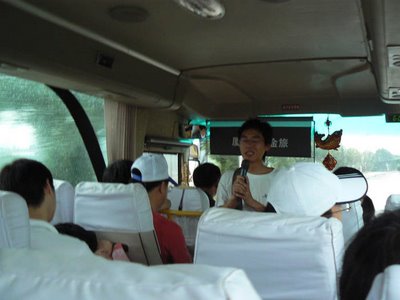
The first think we did was climb some mountains. When I got my first look I don't know what to say. It was so beautiful I wanted to cry. I'd have to visit the big island of Hawai'i again to really say for certain, but it may have been the most impressive nature I've ever seen in my life. Photos don't quite capture it:

The paths were well-defined, often with stairs cut into the mountainside. Some sections could be extremely steep, and it was raining real hard at times. So there'd be a line of people, one after the other, going up a single step at a time. It sounds annoying but the view was so impressive I could have cared less. In retrospect, maybe I should have been scared - if one person had fallen on the steep slippery steps, everybody behind them would have followed like Dominos!
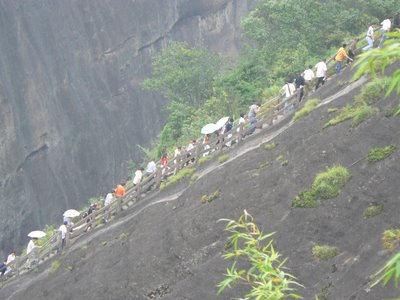
The cliffs were stark. Walking through them evoked all the cliches as once: walking through a Chinese painting, walking through a Martian landscape, etc...

There were a few pieces of historical interest scattered throughout. This Buddha, carved out of the rock, was impressive, although it looks like a modern re-construction:

Also scattered about were tea groves. They were so scenic and small, I at first thought they were purely for decoration, until I noticed it was one scenic and small grove after the other:
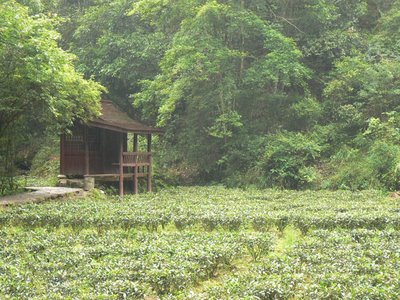
I'll have more to say and more scenery to show in part two, in the next couple of days.
Subscribe to:
Posts (Atom)